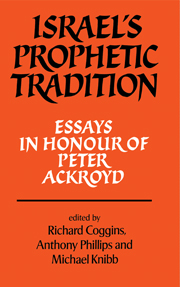Book contents
- Frontmatter
- Contents
- Preface
- Biographical note
- Abbreviations
- Note
- Prophecy in the ancient Near East
- The origins of prophecy in Israel
- Three classical prophets: Amos, Hosea and Micah
- The Isaiah tradition
- An alternative prophetic tradition?
- Visionary experience in Jeremiah
- The Ezekiel tradition: prophecy in a time of crisis
- The prophets of the restoration
- Prophecy and the emergence of the Jewish apocalypses
- Prophecy and wisdom
- Prophecy and the cult
- Prophecy and law
- A change of emphasis in the study of the prophets
- Martin Buber and the interpretation of the prophets
- Index of Biblical References
The Isaiah tradition
Published online by Cambridge University Press: 09 January 2010
- Frontmatter
- Contents
- Preface
- Biographical note
- Abbreviations
- Note
- Prophecy in the ancient Near East
- The origins of prophecy in Israel
- Three classical prophets: Amos, Hosea and Micah
- The Isaiah tradition
- An alternative prophetic tradition?
- Visionary experience in Jeremiah
- The Ezekiel tradition: prophecy in a time of crisis
- The prophets of the restoration
- Prophecy and the emergence of the Jewish apocalypses
- Prophecy and wisdom
- Prophecy and the cult
- Prophecy and law
- A change of emphasis in the study of the prophets
- Martin Buber and the interpretation of the prophets
- Index of Biblical References
Summary
Our subject may be broached, happily enough, by notice of Peter Ackroyd's article ‘Isaiah I-XII’ He criticises the frequent assumption that lsa. 1–39 can be treated as a separate book, and that the position of the narrative section chs. 36–9 confirms this. He suggests that such narratives have rather been added at significant points within prophetic collections. His reflections thus turn our minds once more to the question of the book as a whole.
Time was when the emphasis of scholarship had all to be on proving that Isaiah was not the author of 40–66, as well illustrated by Driver (1891). New ways of regarding the relationship of earlier and later strata of the book came into view with the growing interest in prophetic disciples as bearers of tradition. Mowinckel (1926) attempted to visualise Isaiah's community of disciples in some detail – the various classes from which the members were drawn, their common concerns and the texts (extending into other prophetic collections and Deuteronomy) that they produced, especially in the seventh century. He considered that lsa. 40–55 was added to the collection fairly certainly because the author, Deutero-Isaiah, arose from the Isaiah circle or sect. Engnell (1962) was characteristically emphatic: the book was a tradition-work consisting of three major collections (Proto-, Deutero-, Trito-Isaiah), which emanated from three tradition-circles. The living bond that connected the circles reached back also to Isaiah, and Isaianic material was present in all three collections, though especially the first.
- Type
- Chapter
- Information
- Israel's Prophetic TraditionEssays in Honour of Peter R. Ackroyd, pp. 58 - 76Publisher: Cambridge University PressPrint publication year: 1982



